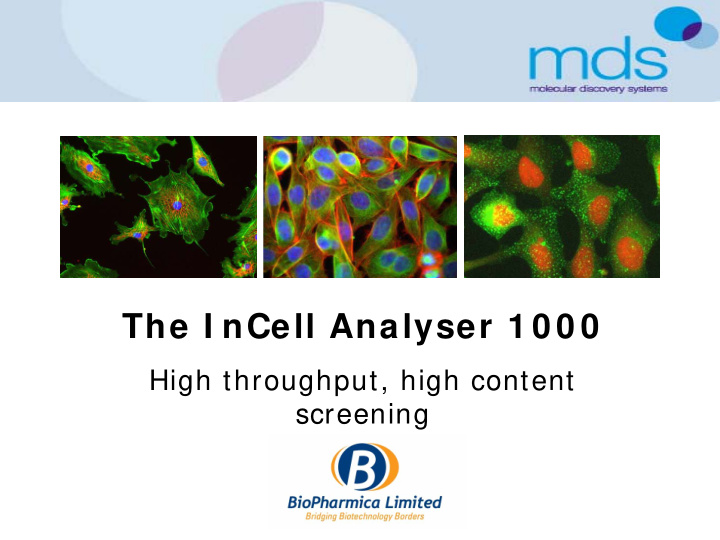



The I nCell Analyser 1 0 0 0 High throughput, high content screening
The InCell Analyser 1000 Automated cellular and subcellular imaging system. Built around epifluorescent based microscope and image acquisition software. Fixed and live cell imaging. Images maximum of 3 fluorescent wavelengths plus brightfield image. Acquires up to 2000 images per hour.
Hardware overview Optical Path SBS plate compatible High-speed laser autofocus <400msec per image High NA Objectives 4x, 10x, 20x, 40x Dichroic mirrors CCD camera CoolSNAP HQ Low noise high sensitivity Excitation Emission Illumination 6 position wheel 6 position wheel 100W xenon lamp
Dichroic Mirrors Excitation Emission Dichroic mirror D360/40 HQ460/40 51008bs(FITC/Cy5) HQ405/20 HQ480/40 Q505LP (DAPI/FITC) D436/20 HQ535/50 51013bs (DAPI/Cy5) S475/20 HQ570/30 HQ500/20 HQ620/60 HQ535/50 HQ700/75 HQ570/20 HQ620/60 View from left-hand side of instrument showing position of dichroic mirrors
Objectives Numerical Objective Objective Working Field of View Resolution Aperture Magnification Type Distance - mm (FOV) (NA) Plan 3.76mm 2 4X 0.2 15.7 1.60µm / pixel Apochromat Plan 0.60mm 2 10X 0.45 4.0 0.65µm / pixel Apochromat ELWD Plan 0.15mm 2 20X 0.45 7.4 0.32µm / pixel Fluor ELWD Plan 0.04mm 2 40X 0.6 3.7 – 2.7 0.16µm / pixel Fluor 4x Plan Apo 0.20NA 10x Plan Apo 0.45NA 10x 20x 40x 20x Plan Fluor ELWD 40x Plan Fluor ELWD 0.45NA 0.6NA Molecular Probes Fluocells prepared slide #1. ~ 1500 cells ~ 200-400 cells ~ 50-100 cells BPAE cells with MitoTracker Red CMXRos, BODIPY FL phallacidin, DAPI
Plate Manager Pre loaded with standard plate dimensions. New plate maps can be added as required. User specifies area the wells and the areas within wells to be imaged. Stores acquisition footprint.
Autofocus Cells Plastic/liquid interface Air/plastic interface Objective Autofocus Autofocus offset Laser based autofocus system Biology located using software algorithm Detects flat optical surfaces Defined ex/em λ and exposure times Locates plastic/liquid interface at Collects series of images acquired in z-axis each well Determines best focal position Rapid, <400ms/well
Optional Features of Image Acquisition Variable temperature control User defined optional plate heating (25 - 42 ° C). Useful for medium term, live cell imaging. Liquid handling Dispensing or aspirating reagent from 96- and 384- plates. Image combination Creates a single focused image from a set of images acquired at different focal planes. Particularly useful for thick specimens. Z dimension Allows collection of a set of images at different focal planes Up to 50 Z-dimension slices +/- 100 microns from HWAF position. Time series Allows consecutive image capture over a set period of time i.e. every 30 minutes over 24 hours.
Great data starts with great images!
I nCell Softw are packages Workstation Developer Toolbox Analysis protocols based on preset Build protocols from scratch. modules i.e. Object intensity, Much greater flexibility in analysis granularity, nuclear trafficking capability. Some ‘training’ capabilities but core Excellent for multiplex assays. algorithms cannot be changed.
Basic Analysis Protocol Define input images, wavelengths, assign objects Segment objects e.g. define nuclei, cells, organelles Select basic measurements e.g. intensity, area, cell/nuclear intensity Summarise measurements
Object Intensity Quantifies changes in fluorescent labels in cells. Potential applications include cell viability (membrane permeability), ion mobilisation, membrane potential, protein expression and enzyme activity. Requires two fluorophores with distinct spectral profiles required to distinguish nuclei from intensity reporter. Measurements include; mean cell intensity, mean cytoplasm intensity, mean nuclei intensity etc.
-TGF Nuclear Trafficking Quantifies movement of proteins between the nucleus and cytoplasm (in either direction). Two fluorophores required to distinguish +TGF nulcei and translocating molecules. Types of measurements include; mean N/C intensity, SD N/C intensity, mean nuclei intensity, mean cytoplasm intensity etc. EGFP-SMAD-2 translocation from the cytoplasm to the nucleus
Granularity A B Quantifies shape, size and intensity of granules within cells. 2 fluorophores with distinct spectral profiles required to distinguish nuclei from granules. C D Types of measurements include total granule area, granule area/cell, granule count, granule count/cell, mean granule area etc.
I m age Analysis
Developer Toolbox Allows development of own automated analysis routines. Advanced segmentation tools. Macros (all graphical – no programming). Unlimited measurements.
Proliferation Assays Counting nuclei of treated cells over a period of time. More accurate than traditional biochemical assays (MTT, WST1) which rely on indirect quantitation methods (cellular protein content). Fixed or live cells (fluorescently tagged stable cell lines). O hours 24 hours 48 hours
Quantitation of non-uniform cellular bodies Quantitation of non-uniform actin rings following PDGF treatment. Measurements reflect the degree of ‘actin ring’ formation. - PDGF 10’ PDGF
Protein Expression in Mouse Muscle Fibres High-throughput screening of chemical library for compounds that upregulate expression of three genes of interest. 96 well plate format. Fibres stained with three fluorophores tagging proteins for quantitation. Analysis based on an object intensity multiplex.
Molecular Discovery Systems Lab G69, B Block QEII Medical Centre Hospital Avenue, Nedlands Australia 6009 Lab G69 Office Tel: +61 8 9346 7404 rachel@mdsystems.com.au
Recommend
More recommend